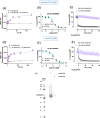Ligand-Directed Labeling of the Adenosine A1 Receptor in Living Cells
- PMID: 38994645
- PMCID: PMC11284787
- DOI: 10.1021/acs.jmedchem.4c00835
Ligand-Directed Labeling of the Adenosine A1 Receptor in Living Cells
Abstract
The study of protein function and dynamics in their native cellular environment is essential for progressing fundamental science. To overcome the requirement of genetic modification of the protein or the limitations of dissociable fluorescent ligands, ligand-directed (LD) chemistry has most recently emerged as a complementary, bioorthogonal approach for labeling native proteins. Here, we describe the rational design, development, and application of the first ligand-directed chemistry approach for labeling the A1AR in living cells. We pharmacologically demonstrate covalent labeling of A1AR expressed in living cells while the orthosteric binding site remains available. The probes were imaged using confocal microscopy and fluorescence correlation spectroscopy to study A1AR localization and dynamics in living cells. Additionally, the probes allowed visualization of the specific localization of A1ARs endogenously expressed in dorsal root ganglion (DRG) neurons. LD probes developed here hold promise for illuminating ligand-binding, receptor signaling, and trafficking of the A1AR in more physiologically relevant environments.
Conflict of interest statement
The authors declare no competing financial interest.
Figures










Similar articles
-
Structure-based discovery of positive allosteric modulators of the A1 adenosine receptor.Proc Natl Acad Sci U S A. 2025 Jul 15;122(28):e2421687122. doi: 10.1073/pnas.2421687122. Epub 2025 Jul 7. Proc Natl Acad Sci U S A. 2025. PMID: 40623180 Free PMC article.
-
Development and Application of Subtype-Selective Fluorescent Antagonists for the Study of the Human Adenosine A1 Receptor in Living Cells.J Med Chem. 2021 May 27;64(10):6670-6695. doi: 10.1021/acs.jmedchem.0c02067. Epub 2021 Mar 16. J Med Chem. 2021. PMID: 33724031
-
Impact of ligand binding on VEGFR1, VEGFR2, and NRP1 localization in human endothelial cells.PLoS Comput Biol. 2025 Jul 16;21(7):e1013254. doi: 10.1371/journal.pcbi.1013254. eCollection 2025 Jul. PLoS Comput Biol. 2025. PMID: 40668864 Free PMC article.
-
Real-time imaging of axonal membrane protein life cycles.Nat Protoc. 2024 Sep;19(9):2771-2802. doi: 10.1038/s41596-024-00997-x. Epub 2024 Jun 3. Nat Protoc. 2024. PMID: 38831222 Free PMC article. Review.
-
Implication of Bimodal Magnetic Resonance and Fluorescence Imaging Probes in Advanced Healthcare: Enhancing Disease Diagnosis and Targeted Therapy.Int J Nanomedicine. 2025 Jul 29;20:9473-9503. doi: 10.2147/IJN.S524454. eCollection 2025. Int J Nanomedicine. 2025. PMID: 40755465 Free PMC article. Review.
Cited by
-
Ligand-directed covalent labelling of adenosine receptors.Purinergic Signal. 2025 Feb 24. doi: 10.1007/s11302-025-10073-y. Online ahead of print. Purinergic Signal. 2025. PMID: 39992595 No abstract available.
-
Covalent functionalization of G protein-coupled receptors by small molecular probes.RSC Chem Biol. 2025 Feb 14;6(4):528-538. doi: 10.1039/d4cb00294f. eCollection 2025 Apr 2. RSC Chem Biol. 2025. PMID: 39957994 Free PMC article. Review.
-
A modular click ligand-directed approach to label endogenous dopamine D1 receptors in live cells.Commun Chem. 2025 Apr 11;8(1):113. doi: 10.1038/s42004-025-01504-3. Commun Chem. 2025. PMID: 40216891 Free PMC article.
-
Biocompatible Sulfonium-Based Covalent Probes For Endogenous Tubulin Fluorescence Nanoscopy In Live And Fixed Cells.Res Sq [Preprint]. 2025 Feb 4:rs.3.rs-5922324. doi: 10.21203/rs.3.rs-5922324/v1. Res Sq. 2025. PMID: 39975932 Free PMC article. Preprint.
References
-
- Los G. V.; Al D.; Learish R.; McDougall M. G.; Encell L. P.; Friedman-Ohana R.; Wood M.; Vidugiris G.; Zimmerman K.; Otto P.; Klaubert D. H.; Wood K.. One Fusion Protein: Multiple Functions, Promega Notes 89, 2005; pp 2–6.
Publication types
MeSH terms
Substances
LinkOut - more resources
Full Text Sources
Research Materials

